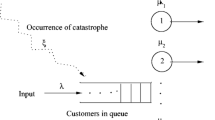Abstract
A novel multi-server vacation queuing approach based on Markov chains with a random transition is being investigated for single phase server failure. The mathematical study of lines of people waiting for something is known as “queuing theory”. A simple queuing system has three main parts: the arrival procedure, the queue, and the service procedure. The model’s self-sufficiency of servers sets it apart from conventional queues. A server can shut down and take a vacation without the permission of the system management or the overall system state. The system administrator’s discretion is whether a server can resume processing clients once vacation is over. One way to think about the arrival process is as a generalized batch Markov one. The question of how many servers to have and the thresholds at which the management makes choices becomes an issue. The system’s behavior might be explained using a three-dimensional Markov chain with a unique generator block structure. The ergodicity of this chain is established, and the issue of computing the steady-state distribution is examined in detail. The distribution of chain states is used to create expressions for performance measures. A representation of a numerical result demonstrates that as N is the number of servers and the average number of consumers in the N buffer grows concerning rising in the parameter J1 and the loss probability P loss increases when the parameter J1 is increased and decreases as the number of servers N is increased.
Access this chapter
Tax calculation will be finalised at checkout
Purchases are for personal use only
Similar content being viewed by others
References
Obulor R, Eke BO (2016) Outpatient queuing model development for hospital appointment system. Int J Sci Eng Appl Sci (IJSEAS) 2(4):15–22
Chakravarthy SR, Kul Shrestha R (2020) A queueing model with server breakdowns, repairs, vacations, and backup servers. Oper Res Perspect 7:100131
Vermeer S, Trilling D (2020) Toward a better understanding of news user journeys: a Markov chain approach. J Stud 21(7):879–894
Grewal JK, Krzywinski M, Altman N (2019) Markov models—Markov chains. Nat Methods 16:663–664
Dudin A, Dudina O, Dudin S, Samouylov K (2021) Analysis of multi-server queue with self-sustained servers. Mathematics 9(17):2134
Yu K, Sato T (2019) Modeling and analysis of error process in 5G wireless communication using two-state Markov chain. IEEE Access 7:26391–26401
Vahdani B, Tavakkoli-Moghaddam R, Modarres M, Baboli A (2012) Reliable design of a forward/reverse logistics network under uncertainty: a robust-M/M/c queuing model. Transp Res Part E Log Transp Rev 48(6):1152–1168
Dudin S, Dudina O (2019) Retrial multi-server queuing system with PHF service time distribution as a model of a channel with the unreliable transmission of information. Appl Math Model 65:676–695
Thakur S, Jain A, Jain M (2021) ANFIS and cost optimization for Markovian queue with operational vacation. Int J Math Eng Manag Sci 6(3):894–910
Kalita P, Choudhury G (2021) Analysis of batch arrival single server queue with random vacation policy and two general heterogeneous repeated service types. Int J Oper Res 42(2):131–162
Sivasamy R, Peter PO (2021) A c-server Poisson queue with customer impatience due to a slow-phase service. Int J Math Oper Res 20(1):85–98
Singh A, Chauhan P, Mamatha TG (2020) A review on the tribological performance of lubricants with nanoparticle additives. Mater Today Proc 25:586–591
Baumann H, Hanschke T (2020) Computation of invariant measures and stationary expectations for Markov chains with block-band transition matrix. J Appl Math
Haque O, Akter S, Hossen A, Rahman Z (2020) A case study on outpatient waiting time for treatment with single server queuing model at public eye hospital in Bangladesh. Am Acad Sci Res J Eng Technol Sci 68(1):143–151
Bordenave C, Caputo P, Salez J (2019) Cutoff at the “entropic time” for sparse Markov chains. Probab Theory Relat Fields 173(1):261–292
Zaki NHM, Saliman AN, Abdullah NA, Hussain NSAA, Amit N (2019) Comparison of queuing performance using queuing theory model and fuzzy queuing model at check-in counter in the airport. Math Stat 7(4):17–23
Ma Z, Koutsopoulos HN, Ferreira L, Mesbah M (2017) Estimation of trip travel time distribution using a generalized Markov chain approach. Transp Res Part C Emerg Technol 74:1–21
Singh CJ, Jain M, Kumar B (2014) Analysis of MX/G/1 queueing model with balking and vacation. Int J Oper Res 19(2):154–173
Srinath KR (2017) Python–the fastest-growing programming language. Int Res J Eng Technol (IRJET) 4(12):354–357
Author information
Authors and Affiliations
Corresponding author
Editor information
Editors and Affiliations
Rights and permissions
Copyright information
© 2023 The Author(s), under exclusive license to Springer Nature Singapore Pte Ltd.
About this paper
Cite this paper
Singh, R., Solanki, V.K. (2023). A Queuing Model for Single Phase Server Breakdown Using Markov Chains with Random Transition. In: Tuba, M., Akashe, S., Joshi, A. (eds) ICT Infrastructure and Computing. ICT4SD 2023. Lecture Notes in Networks and Systems, vol 754. Springer, Singapore. https://doi.org/10.1007/978-981-99-4932-8_24
Download citation
DOI: https://doi.org/10.1007/978-981-99-4932-8_24
Published:
Publisher Name: Springer, Singapore
Print ISBN: 978-981-99-4931-1
Online ISBN: 978-981-99-4932-8
eBook Packages: Intelligent Technologies and RoboticsIntelligent Technologies and Robotics (R0)




